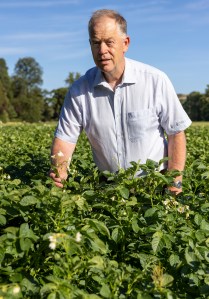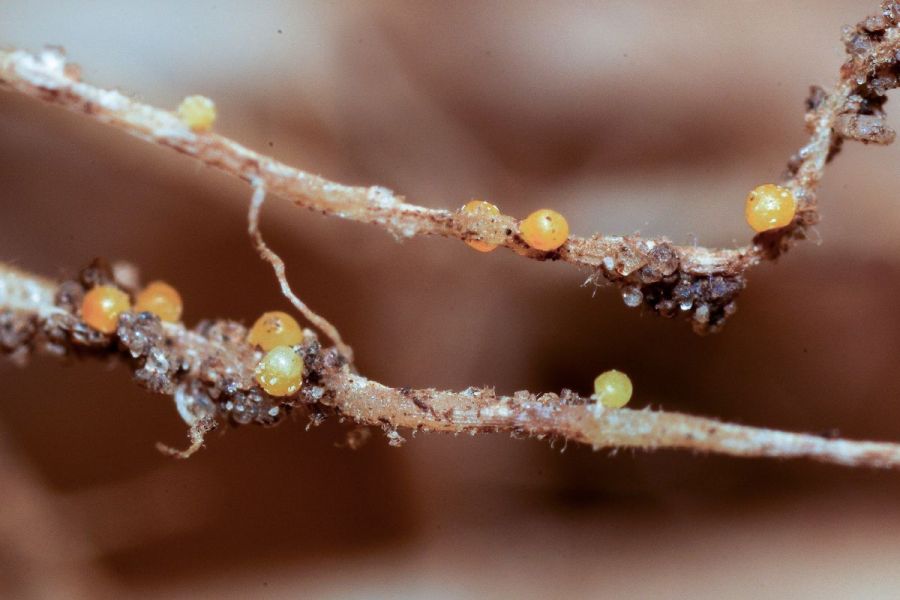From cover crops to clean seed to nematicides, it’s all part of an integrated approach to nematode control. CPM digs into the detail but finds there’s far from an oven-ready strategy across the industry.
“Supermarkets have the power to steer a course towards varieties with good resistance and tolerance but aren’t invested in developing sustainable solutions.”
By Rob Jones
For all the problems created by higher energy and input costs as well as the pressure to reduce carbon emissions, it’s potato cyst nematodes (PCN) that many advisers consider to be the existential threat to the sector.
PCN, and to a lesser extent their migratory cousins, free-living nematodes (FLN), present a problem that spans the industry – and the country.
Specifically, it is the fear that Nemathorin (fosthiazate) could be withdrawn in 2024 that has exposed the seriousness of the situation. Without the yield protection afforded by high-volume granular nematicides, there’s a risk that vast swathes of otherwise productive potato land will be taken out of production.

The real hurdle to progress is retailer preference for those varieties that exacerbate the PCN situation, says Eric Anderson.
“Unless we take action now, we’re looking at a three- to five-year period during which the potato area in Great Britain is likely to collapse,” says Eric Anderson, senior agronomist for Scottish Agronomy.
“Even if the varieties with good resistance and tolerance to Globodera pallida, and to a lesser extent G. rostochiensis, had broad market acceptance – which they don’t – it would still take five to six years to multiply seed stocks needed to meet grower demand. I fear that we could lose a big part of our industry before anyone accepts the need for change,” he says.
While there are signs that some of the processors are making positive changes, there are concerns that some of the multiple retailers are less forward-looking.
“McCain is moving towards King Russet, a French fries variety with good resistance – scores of 9 – to both G. pallida and G. rostochiensis. Elland, which has good resistance to G. pallida but only partial resistance to G. rostochiensis, is being trialled by some packers but it accounts for a relatively small volume.
“The real hurdle to progress is retailer preference for those varieties that exacerbate the situation. Supermarket buyers have the power to steer a course towards those varieties with good resistance and tolerance to both species of PCN, but aren’t invested in developing sustainable solutions,” says Eric.
While PCN may dominate discussions, it’s only a part of the nematode threat. Stubby-root nematodes (Trichodorus and Paratrichodorus), a type of FLN, are of increasing concern. Stubby-root nematodes vector tobacco rattle virus (TRV) while the feeding damage inflicted on roots leads to an increased risk of internal rust spot (IRS), he explains.
TRV manifests as necrotic rings in the flesh of tubers in ‘spraing’. More than 5% internal defects from TRV, and the batch is likely to be rejected from packing with a significant loss in value to the grower. Root damage means the plant is less able to absorb water and nutrients from the soil. Where this results in restricted calcium uptake, it often leads to increased incidence of IRS, says Eric.
“Calcium is moved passively through the water transpiration stream so it should be applied in the rooting zone if it’s to be moved to the tubers. Applying calcium as a foliar spray is ineffective as there’s no movement of calcium between the foliage and the tubers. Applying a nematicide and scheduling adequate irrigation will protect root function while supporting water and nutrient uptake.”
Some varieties are described as having resistance to TRV, but the supporting data is often so incomplete that it’s rarely enough to support decisions, claims Eric. “There isn’t the depth of data needed to assess a variety for TRV susceptibility in the absence of a granular nematicide. It means the grower is left to carry the risk.”
At a 2022 trial in Strathmore, Scottish Agronomy investigated the incidence of TRV and IRS in varieties popular in the region but grown without a granular nematicide. The results served to underline the value of a granular nematicide in reducing internal damage.
“Detailed information on varietal resistance to TRV is scarce at best. Much of what’s available is based on limited assessments. The strain of TRV in the Vale of York or Strathmore, for example, may be different to that in Cambridgeshire where most assessments are performed,” he says.

The rate at which a PCN population declines in the absence of a host varies between species but is also influenced by environmental factors such as soil type, says Nick Winmill.
Until more varieties with both strong resistance and tolerance gain market acceptance, growers are encouraged to adopt policies involving more integrated measures. For Nick Winmill, Agrii head of potato R&D, developing an IPM approach for PCN and FLN begins with field selection, but it encompasses everything – from certified seed to good weed control, to diligent use of nematicides, to resistant varieties, where possible, and cover crops.
“We need to be far more objective when risk-assessing sites. Too many fields are planted that shouldn’t be. Rotations of less than one-in-six make it hard to have a positive effect on populations, especially with G. pallida,” he says.
The rate at which a population declines in the absence of a host varies between species but is also influenced by environmental factors such as soil type. For G. pallida, annual decline ranges from 4-40% per year but is typically in the region of 20%. For G. rostochiensis, rates are less variable at about 30% per annum.
Cover crops, principally trap crops such as sticky nightshade (Solanum sisymbriifolium) and biofumigants such as oil radish (Raphanus sativus), have been found to positively impact populations. The seed costs, management input and establishment difficulties, however, have discouraged many growers from realising their potential, he expains.
“Success with these cover crops varies between regions and sites, so perseverance is key. We have had good experience with DeCyst, a sticky nightshade from Produce Solutions. Where it’s done well, we have seen it outperform several biofumigants and it doesn’t require the care with maceration and incorporation that some alternatives require.”
In Scotland, where a shorter growing season is typical, oil radish has emerged as a favourite among those keen to bring populations down, adds Eric. “Like Indian mustard, oil radish, especially the variety Bento, is high in the glucosinolates that are converted into volatile isothiocyanates, a form of mustard gas. But where these are concentrated in the leaves and stems of Indian mustard, in oil radish they are in the root.
“This removes the need for maceration and incorporation as they are continually released into the soil through the feeding activity of herbivores and soil biota,” he adds.
Cover crops are of increasing interest given their potential to improve soil organic matter levels, but growers should be wary of those species with the potential to support FLN, warns Eric. “Some species of cover crop, notably Phacelia and black oat, positively support Pratylenchus nematode populations, so growers should be wary of inadvertently making the situation worse.
“Conversely, with oil radish, we’ve seen instances where populations have significantly reduced. It can take several crops of oil radish within the rotation, but to those involved it represents an investment in the future of the far,” he says.
“Good weed control, and this extends to careful choice of those species sown as cover crops or game cover, is essential for managing FLN. We see that where it isn’t practiced, populations rise significantly,” reiterates Nick.
Good groundkeeper control has a role to play too, both in-crop and between crops, especially for PCN, if the rate of natural decline is to be sustained, he adds.
The yield protection afforded by nematicides is often influenced by factors beyond the grower’s control, such as the PCN species present, soil type and the extent of feeding sites on the roots, but few would argue that their use isn’t worthwhile, say Nick. The question is what to use and how to make the most of its contribution.
“Anything less than a zero-tolerance approach to PCN is unlikely to succeed, but there are considerations that will influence strategy.”
In short-season crops, such as salads, growers are precluded from using Nemathorin due to the 17-week harvest interval but in main crop potatoes, growers have the option to apply it alone or in sequence with Velum Prime (fluopyram). This flexibility can be useful in constructing a strategy, he suggests.
“Salad varieties are as vulnerable to PCN as main crop and, increasingly, FLN is a threat too. In such a situation Velum Prime is the only means of control. Whether to apply it as an in-furrow spray at planting or as a broadcast spray before cultivating to a depth of 10-20cm is for the grower to decide. In our ware crop trials we see that while one method might work better in one year, there’s no statistical difference in performance when viewed across the seasons,” explains Nick.
Within main crop varieties, the strategy is equally straightforward. “There’s a debate about thresholds and at what point does it become viable to apply a nematicide. In practice, PCN eggs and juveniles at any number should be seen as indicators to treat the field.
“Full-rate Nemathorin is the minimum response, but we have also seen half-rate Nemathorin in sequence with Velum Prime work consistently well, sometimes better,” he says.
In manufacturer trials between 2018 and 2021, Velum Prime in sequence with half-rate Nemathorin achieved an extra 3.1t/ha in gross yield over Nemathorin only. The uncertain regulatory future of Nemathorin has led members of the Potato Partnership, a group of growers and advisers that came together to build on the work of AHDB Potatoes Spot Farm East, to investigate how best to exploit Velum Prime’s contribution to PCN control.
“It has been the focus of one of our trials last year and will be again in 2023. It performed well in combination with half-rate Nemathorin (15kg/ha), but we think that there is more to learn about application practices that could further support performance,” says Nick.
Groundkeeper control
The reliance on rented land is seen as one reason why volunteer control is perhaps not practised to the standard it should be. The effect of this is that nematode populations are increasing for every year that a volunteer potato emerges uncontrolled.
To understand the rate of escalation that might occur, evaluation by a team from PCN Action Scotland provided what is believed to be the first qualitative data on the impact of volunteers on PCN populations.
“In 2022, soil was sampled directly under the root of a volunteer potato and again at a metre away across 34 paired samples. On average, the Pf:Pi ratio increase was 16-fold, though it ranged from 2-fold to 500-fold,” explains Eric.
“There was a clear link between PCN populations and the rate of increase. In low populations, the rate of multiplication was higher, while in higher population situations the increase was lower. The implication is that in fields with potato groundkeepers, this is not a rotation; it is akin to growing potatoes every year,” he concludes.
Variety breakthrough for G.pallida management
Latest results from a five-year research project, PCN Action Scotland, confirm the effectiveness of potato varieties that combine tolerance with high levels of resistance to the pest, especially the dominant G.pallida species.
Set up to deliver a sustainable potato industry for Scotland, the collaborative project estimates that one third of the area of land available for seed potato production in Scotland is infested with PCN, with levels in ware land also increasing significantly.
And as the G.pallida strain of PCN has increased by 145% since 2010, the nematode is on course to compromise the amount of land that can be used to grow seed potatoes unless better, integrated practices to manage it are implemented, say researchers.
With chemical nematicides facing an uncertain future and continued inflationary pressures on farming, genetic solutions are viewed as key for sustainable production.
In the trials, new potato varieties with combined resistance and tolerance, such as Elland, reduced initial G.pallida levels of over 30eggs/g or higher to negligible counts post-harvest – giving growers the tools to effectively clean up their land.
Their uptake now requires a whole supply chain effort, stress the experts, who have been encouraged by major retailers and processors who are starting to recognise their value and list them.
Two key genetic traits are required in potato varieties to manage PCN – resistance and tolerance, says Alistair Redpath of potato breeder Cygnet PB, who has seen increased interest in its variety Elland for this reason.
“A variety with resistance and tolerance will stop PCN multiplying and yield well where they are present,” he says.
“That’s in contrast to one with just resistance, where yield is not protected, or with tolerance alone, as that doesn’t restrict the multiplication of PCN.”
Elland has performed well, both in trials and on-farm, he reports, demonstrating its suitability for both processing and pre-pack markets. As a result, sales of the variety have increased sharply since it was launched in 2019 and accepted by McCain last year.
More recently, both Sainsbury’s and Asda have included the variety in their listings, with other retailers currently evaluating Elland for their own uses and likely to follow suit.
“There’s far greater understanding of the practical difficulties posed by G.pallida, in particular, and the environmental benefits of growing a variety like Elland,” adds Alistair.
“Now that there’s recognition of their place in sustainable farming systems, it’s up to the processors and packers to do their bit so that growers and consumers can benefit from them, not just in Scotland, but in all areas of GB with a G.pallida problem.”
Paul Coleman, of the potato forecasting services group Crop4Sight, welcomes the arrival of good pre-pack potato varieties with G.pallida resistance.
“These variety developments are very timely,” he says. “The last granular nematicide on the market is being reviewed next year and may not be with us in 2025. “Growers have much to thank the breeders for.”
This article was taken from the latest issue of CPM. For more articles like this, subscribe here.
Sign up for Crop Production Magazine’s FREE e-newsletter here.




